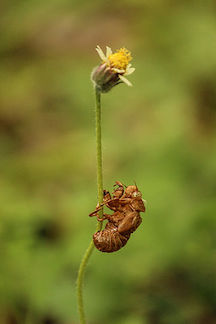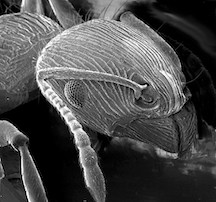昆虫遗骸的测年,使用的是其甲壳素构成的外骨骼。甲壳素是一种由多糖组成的纤维物质。由于昆虫外骨骼的体积和重量非常小,以往很难对其进行年。然而,随着加速器质谱仪(AMS)技术的发展,精准的放射性碳测年只需要非常少量的甲壳素,例如3-4个头部或5-6段完整的翼段(Elias, 2010)。
 昆虫的碳-14测年在考古和古环境研究中具有重要意义。例如,曼切斯特博物馆已经完成了昆虫和木乃伊的大量工作。研究人员发现了木乃伊腐烂后产生的昆虫(比如Anthrenus museorum L.),以及在裹尸过程中与木乃伊结合在一起的昆虫 (比如Chrysomya albiceps) (David, 1979),最近利用AMS技术对其进行了测年(Panagiotakopulu et al. 2014)。然而,这些研究发现,在木乃伊化过程中使用的化学物质(例如沥青),会对昆虫甲壳素测年的可靠性产生影响。为了验证昆虫的年龄,可以对同期植物进行平行年龄测试(Panagiotakopulu et al. 2014)。
昆虫的碳-14测年在考古和古环境研究中具有重要意义。例如,曼切斯特博物馆已经完成了昆虫和木乃伊的大量工作。研究人员发现了木乃伊腐烂后产生的昆虫(比如Anthrenus museorum L.),以及在裹尸过程中与木乃伊结合在一起的昆虫 (比如Chrysomya albiceps) (David, 1979),最近利用AMS技术对其进行了测年(Panagiotakopulu et al. 2014)。然而,这些研究发现,在木乃伊化过程中使用的化学物质(例如沥青),会对昆虫甲壳素测年的可靠性产生影响。为了验证昆虫的年龄,可以对同期植物进行平行年龄测试(Panagiotakopulu et al. 2014)。
昆虫外骨骼的甲壳素成分是一种进行进一步同位素测试的理想材料,因为他具有溶解性和衰变性。条件允许时,氮原子、碳原子和锶原子将在甲壳素结构中保持数百年的稳定,用以重建过去的环境(Elias, 2010)。昆虫通过饮食和饮水将这些同位素融入到自身的结构中,从而可以利用它们重建这些同位素在空间和时间上的变化。
 例如,还分析了黑脉金斑蝶翅膀中的甲壳素的锶(87Sr/86Sr),通过对比翅膀与当地土壤和植被化学上的关联,来研究它们的迁移模式(Flockhart et al. 2015)。与其他生物类似,氮和碳同位素也可以用来重建饮食和营养水平。例如,Schimmelmann (2010)证明了昆虫甲壳素的δ15N值会随着营养水平的增加而增加。其他研究,比如食物偏好(Adams et al. 2016)、饮食生态位(Santi-Júnior et al. 2018)、出生来源(Flockhart et al. 2017)和疾病传播(Schmidt et al. 2011)。
例如,还分析了黑脉金斑蝶翅膀中的甲壳素的锶(87Sr/86Sr),通过对比翅膀与当地土壤和植被化学上的关联,来研究它们的迁移模式(Flockhart et al. 2015)。与其他生物类似,氮和碳同位素也可以用来重建饮食和营养水平。例如,Schimmelmann (2010)证明了昆虫甲壳素的δ15N值会随着营养水平的增加而增加。其他研究,比如食物偏好(Adams et al. 2016)、饮食生态位(Santi-Júnior et al. 2018)、出生来源(Flockhart et al. 2017)和疾病传播(Schmidt et al. 2011)。
预处理 – 样品的预处理是很重要的,因为它会直接影响最后的测试结果。欢迎您联系我们,了解预处理方法或报告的相关的内容。
如需放射性碳测年报价单,请填写此表联系我们。
昆虫甲壳素的其他测试服务:稳定同位素测试(δ13C和δ15N)
参考文献:
Adams, M.O., Seifert, C.L., Lehner, L., Truxa, C., Wanek, W. & Fiedler, K. (2016) Stable isotope signatures reflect dietary diversity in European forest moths. Frontiers in Zoology, 13, 37.
David, A.R. Manchester Museum, (1979). Manchester museum mummy project: multidisciplinary research on ancient Egyptian mummified remains. Manchester University Press.
Elias, S.A., (2010). 14 Beetle Chitin Isotope Studies. Developments in Quaternary Sciences, 12, pp.219-222.
Flockhart, D.T., Brower, L.P., Ramirez, M.I., Hobson, K.A., Wassenaar, L.I., Altizer, S. et al. (2017) Regional climate on the breeding grounds predicts variation in the natal origin of monarch butterflies overwintering in Mexico over 38 years. Global Change Biology, 23, 2565–2576.
Flockhart, D.T., Kyser, T.K., Chipley, D., Miller, N.G. and Norris, D.R., (2015). Experimental evidence shows no fractionation of strontium isotopes (87Sr/86Sr) among soil, plants, and herbivores: implications for tracking wildlife and forensic science. Isotopes in environmental and health studies, 51(3), pp.372-381.
Gratton, C. & Forbes, A.E. (2006) Changes in δ13C stable isotopes in multiple tissues of insect predators fed isotopically distinct prey. Oecologia, 147, 615–624.
Panagiotakopulu, E., Higham, T.F., Buckland, P.C., Tripp, J.A. and Hedges, R.E., (2015). AMS dating of insect chitin–A discussion of new dates, problems and potential. Quaternary Geochronology, 27, pp.22-32.
Santi-Júnior, A.D., Botteon, V.W., Mastrangelo, T. & Moreira, M.Z. (2018) Trophic ecology of citrus pests based on stable isotope analysis. Scientia Agricola, 75, 504–508.
Schimmelmann, A., (2011). Carbon, nitrogen and oxygen stable isotope ratios in chitin. In Chitin (pp. 81-103). Springer, Dordrech
Schmidt, O., Dautel, H., Newton, J. & Gray, J.S. (2011) Natural isotope signatures of host blood are replicated in moulted ticks. Ticks and tick-borne diseases, 2, 225–227.
Tripp, J.A., Higham, T.F.G. and Hedges, R.E.M., (2004). A pretreatment procedure for the AMS radiocarbon dating of sub-fossil insect remains. Radiocarbon, 46(1), pp.147-154.
图片来源:Karthik Easvur (CC BY-SA 3.0)和USGS (Public Domain) via Wikimedia Commons
This entry was posted on Friday, February 4th, 2022 and is filed under 放射性碳测年, 稳定同位素测试 .